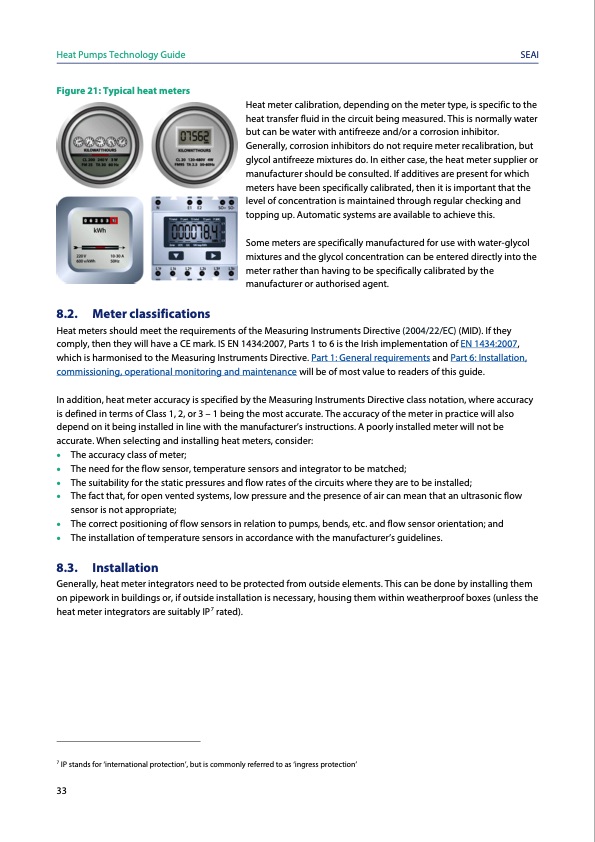
PDF Publication Title:
Text from PDF Page: 037
Heat Pumps Technology Guide SEAI Figure 21: Typical heat meters Heat meter calibration, depending on the meter type, is specific to the heat transfer fluid in the circuit being measured. This is normally water but can be water with antifreeze and/or a corrosion inhibitor. Generally, corrosion inhibitors do not require meter recalibration, but glycol antifreeze mixtures do. In either case, the heat meter supplier or manufacturer should be consulted. If additives are present for which meters have been specifically calibrated, then it is important that the level of concentration is maintained through regular checking and topping up. Automatic systems are available to achieve this. Some meters are specifically manufactured for use with water-glycol mixtures and the glycol concentration can be entered directly into the meter rather than having to be specifically calibrated by the manufacturer or authorised agent. 8.2. Meter classifications Heat meters should meet the requirements of the Measuring Instruments Directive (2004/22/EC) (MID). If they comply, then they will have a CE mark. IS EN 1434:2007, Parts 1 to 6 is the Irish implementation of EN 1434:2007, which is harmonised to the Measuring Instruments Directive. Part 1: General requirements and Part 6: Installation, commissioning, operational monitoring and maintenance will be of most value to readers of this guide. In addition, heat meter accuracy is specified by the Measuring Instruments Directive class notation, where accuracy is defined in terms of Class 1, 2, or 3 – 1 being the most accurate. The accuracy of the meter in practice will also depend on it being installed in line with the manufacturer’s instructions. A poorly installed meter will not be accurate. When selecting and installing heat meters, consider: • The accuracy class of meter; • The need for the flow sensor, temperature sensors and integrator to be matched; • The suitability for the static pressures and flow rates of the circuits where they are to be installed; • The fact that, for open vented systems, low pressure and the presence of air can mean that an ultrasonic flow sensor is not appropriate; • The correct positioning of flow sensors in relation to pumps, bends, etc. and flow sensor orientation; and • The installation of temperature sensors in accordance with the manufacturer’s guidelines. 8.3. Installation Generally, heat meter integrators need to be protected from outside elements. This can be done by installing them on pipework in buildings or, if outside installation is necessary, housing them within weatherproof boxes (unless the heat meter integrators are suitably IP7 rated). 7 IP stands for ‘international protection’, but is commonly referred to as ‘ingress protection’ 33PDF Image | Heat Pumps Technology Guide

PDF Search Title:
Heat Pumps Technology GuideOriginal File Name Searched:
Heat-Pump-Technology-Guide.pdfDIY PDF Search: Google It | Yahoo | Bing
CO2 Organic Rankine Cycle Experimenter Platform The supercritical CO2 phase change system is both a heat pump and organic rankine cycle which can be used for those purposes and as a supercritical extractor for advanced subcritical and supercritical extraction technology. Uses include producing nanoparticles, precious metal CO2 extraction, lithium battery recycling, and other applications... More Info
Heat Pumps CO2 ORC Heat Pump System Platform More Info
| CONTACT TEL: 608-238-6001 Email: greg@infinityturbine.com | RSS | AMP |